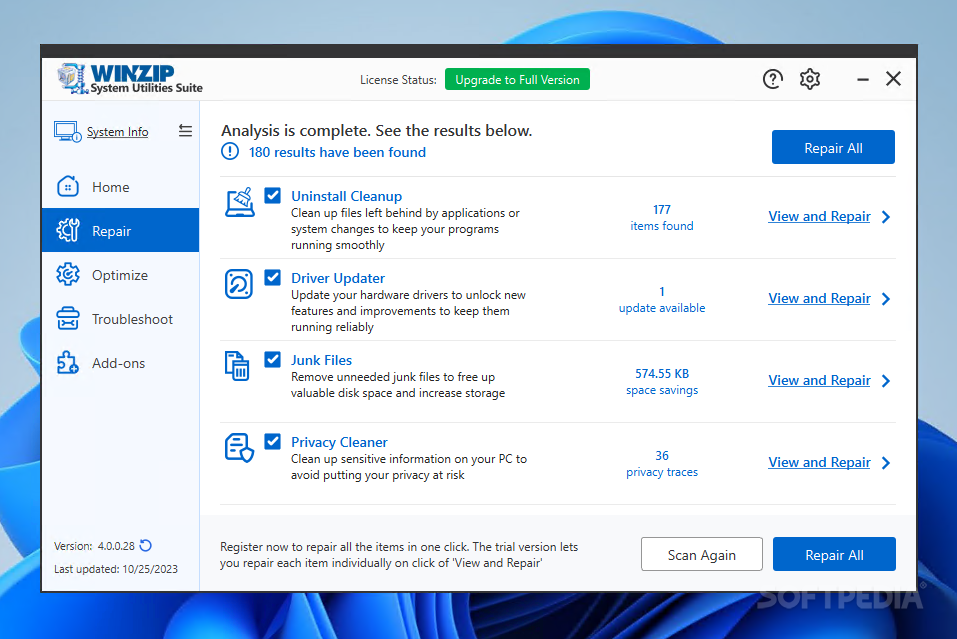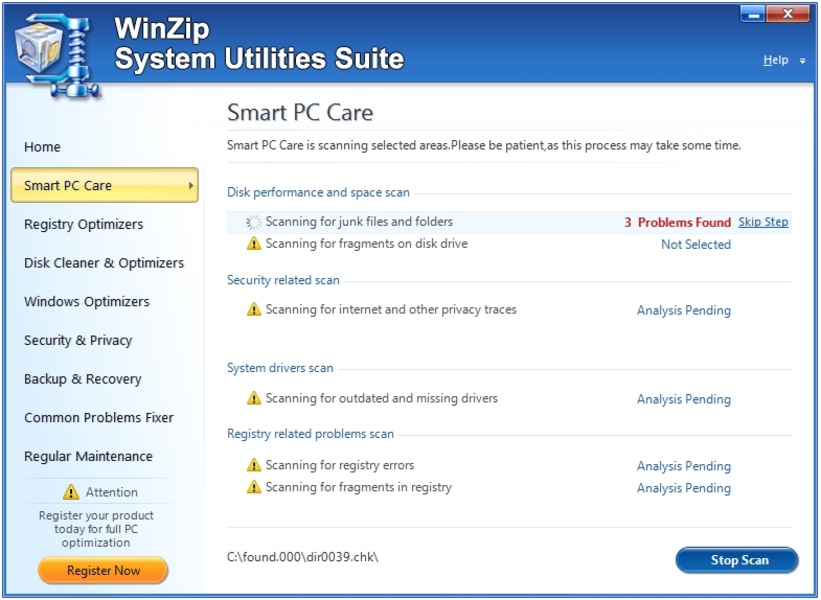![Amazon.com: [Old Version] WinZip 27 Pro | File Management, Encryption, Compression & Backup Software [PC Download] : Everything Else Amazon.com: [Old Version] WinZip 27 Pro | File Management, Encryption, Compression & Backup Software [PC Download] : Everything Else](https://m.media-amazon.com/images/I/71TTTGcqJiL._AC_UF1000,1000_QL80_.jpg)
Amazon.com: [Old Version] WinZip 27 Pro | File Management, Encryption, Compression & Backup Software [PC Download] : Everything Else
![Amazon.com: WinZip 28 | File Management, Encryption & Compression Software [PC Download] : Everything Else Amazon.com: WinZip 28 | File Management, Encryption & Compression Software [PC Download] : Everything Else](https://m.media-amazon.com/images/I/61U4KVDMhVL._AC_UF350,350_QL80_.jpg)
Amazon.com: WinZip 28 | File Management, Encryption & Compression Software [PC Download] : Everything Else

WinZip System Utilities Suite Download: A powerful toolkit that helps you clean, protect, and optimize your system by providing several scanning modes, encryption capabilities, and secure deletion operations
![Amazon.com: WinZip 28 | File Management, Encryption & Compression Software [PC Download] : Everything Else Amazon.com: WinZip 28 | File Management, Encryption & Compression Software [PC Download] : Everything Else](https://m.media-amazon.com/images/I/71iHqzAJu0L._AC_UF1000,1000_QL80_.jpg)
Amazon.com: WinZip 28 | File Management, Encryption & Compression Software [PC Download] : Everything Else
![Amazon.com: Corel WinZip 24 Pro | File Compression & Decompression Software with Essential Backup Tools | Subscription-Free [PC Download] [Old Version] : Everything Else Amazon.com: Corel WinZip 24 Pro | File Compression & Decompression Software with Essential Backup Tools | Subscription-Free [PC Download] [Old Version] : Everything Else](https://m.media-amazon.com/images/I/71YDrCDSQYL._AC_UF1000,1000_QL80_.jpg)
Amazon.com: Corel WinZip 24 Pro | File Compression & Decompression Software with Essential Backup Tools | Subscription-Free [PC Download] [Old Version] : Everything Else
![Amazon.com: WinZip 28 | File Management, Encryption & Compression Software [PC Download] : Everything Else Amazon.com: WinZip 28 | File Management, Encryption & Compression Software [PC Download] : Everything Else](https://m.media-amazon.com/images/I/7158oevCGqL._AC_UF1000,1000_QL80_.jpg)
Amazon.com: WinZip 28 | File Management, Encryption & Compression Software [PC Download] : Everything Else
![Amazon.com: WinZip 28 | File Management, Encryption & Compression Software [PC Download] : Everything Else Amazon.com: WinZip 28 | File Management, Encryption & Compression Software [PC Download] : Everything Else](https://m.media-amazon.com/images/I/71sjSLWPE8L._AC_UF1000,1000_QL80_.jpg)
Amazon.com: WinZip 28 | File Management, Encryption & Compression Software [PC Download] : Everything Else
![Amazon.com: [Old Version] WinZip 27 Pro | File Management, Encryption, Compression & Backup Software [PC Download] : Everything Else Amazon.com: [Old Version] WinZip 27 Pro | File Management, Encryption, Compression & Backup Software [PC Download] : Everything Else](https://m.media-amazon.com/images/I/71nyF9hbElL._AC_UF350,350_QL80_.jpg)
Amazon.com: [Old Version] WinZip 27 Pro | File Management, Encryption, Compression & Backup Software [PC Download] : Everything Else
![Amazon.com: [Old Version] WinZip 27 Pro | File Management, Encryption, Compression & Backup Software [PC Download] : Everything Else Amazon.com: [Old Version] WinZip 27 Pro | File Management, Encryption, Compression & Backup Software [PC Download] : Everything Else](https://m.media-amazon.com/images/I/71AXeBkh0KL._AC_UF1000,1000_QL80_.jpg)
Amazon.com: [Old Version] WinZip 27 Pro | File Management, Encryption, Compression & Backup Software [PC Download] : Everything Else
![Amazon.com: WinZip 28 | File Management, Encryption & Compression Software [PC Download] : Everything Else Amazon.com: WinZip 28 | File Management, Encryption & Compression Software [PC Download] : Everything Else](https://m.media-amazon.com/images/S/aplus-media-library-service-media/a01a4c83-4aa7-46b2-996a-a7b4d137e986.__CR0,0,300,300_PT0_SX300_V1___.jpg)
Amazon.com: WinZip 28 | File Management, Encryption & Compression Software [PC Download] : Everything Else
![Amazon.com: [Old Version] WinZip 27 Pro | File Management, Encryption, Compression & Backup Software [PC Download] : Everything Else Amazon.com: [Old Version] WinZip 27 Pro | File Management, Encryption, Compression & Backup Software [PC Download] : Everything Else](https://m.media-amazon.com/images/I/71AxqwiW4gL._AC_UF350,350_QL80_.jpg)
Amazon.com: [Old Version] WinZip 27 Pro | File Management, Encryption, Compression & Backup Software [PC Download] : Everything Else
![Amazon.com: WinZip 28 | File Management, Encryption & Compression Software [PC Download] : Everything Else Amazon.com: WinZip 28 | File Management, Encryption & Compression Software [PC Download] : Everything Else](https://m.media-amazon.com/images/S/aplus-media-library-service-media/fd035eb9-423a-4dcd-bcf5-47a923212b70.__CR0,0,300,300_PT0_SX300_V1___.jpg)
Amazon.com: WinZip 28 | File Management, Encryption & Compression Software [PC Download] : Everything Else
![Amazon.com: [Old Version] WinZip 27 Pro | File Management, Encryption, Compression & Backup Software [PC Download] : Everything Else Amazon.com: [Old Version] WinZip 27 Pro | File Management, Encryption, Compression & Backup Software [PC Download] : Everything Else](https://m.media-amazon.com/images/I/61x+4xkPP0L._AC_UF1000,1000_QL80_.jpg)
Amazon.com: [Old Version] WinZip 27 Pro | File Management, Encryption, Compression & Backup Software [PC Download] : Everything Else
![Amazon.com: [Old Version] WinZip 27 Pro | File Management, Encryption, Compression & Backup Software [PC Download] : Everything Else Amazon.com: [Old Version] WinZip 27 Pro | File Management, Encryption, Compression & Backup Software [PC Download] : Everything Else](https://m.media-amazon.com/images/S/aplus-media-library-service-media/40460331-5e02-495b-8f89-959d8418aa3a.__CR0,0,970,600_PT0_SX970_V1___.jpg)
Amazon.com: [Old Version] WinZip 27 Pro | File Management, Encryption, Compression & Backup Software [PC Download] : Everything Else
![Amazon.com: Corel WinZip 26 | Zip Compression, Encryption & File Manager Software [PC Download] [Old Version] : Everything Else Amazon.com: Corel WinZip 26 | Zip Compression, Encryption & File Manager Software [PC Download] [Old Version] : Everything Else](https://m.media-amazon.com/images/I/61ogOndQGmL._AC_UF1000,1000_QL80_.jpg)
Amazon.com: Corel WinZip 26 | Zip Compression, Encryption & File Manager Software [PC Download] [Old Version] : Everything Else
![Amazon.com: Corel WinZip 24 Pro | File Compression & Decompression Software with Essential Backup Tools | Subscription-Free [PC Download] [Old Version] : Everything Else Amazon.com: Corel WinZip 24 Pro | File Compression & Decompression Software with Essential Backup Tools | Subscription-Free [PC Download] [Old Version] : Everything Else](https://m.media-amazon.com/images/I/51XAg4fVy3L._AC_UF1000,1000_QL80_.jpg)









